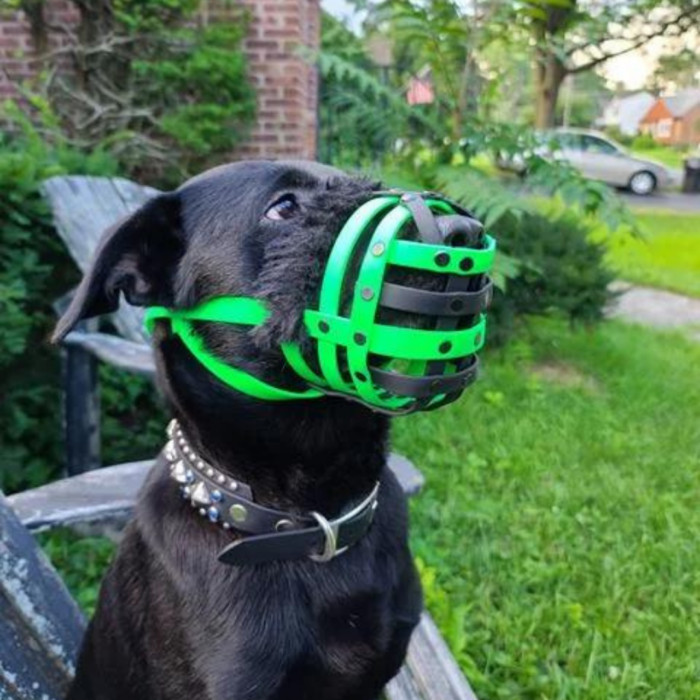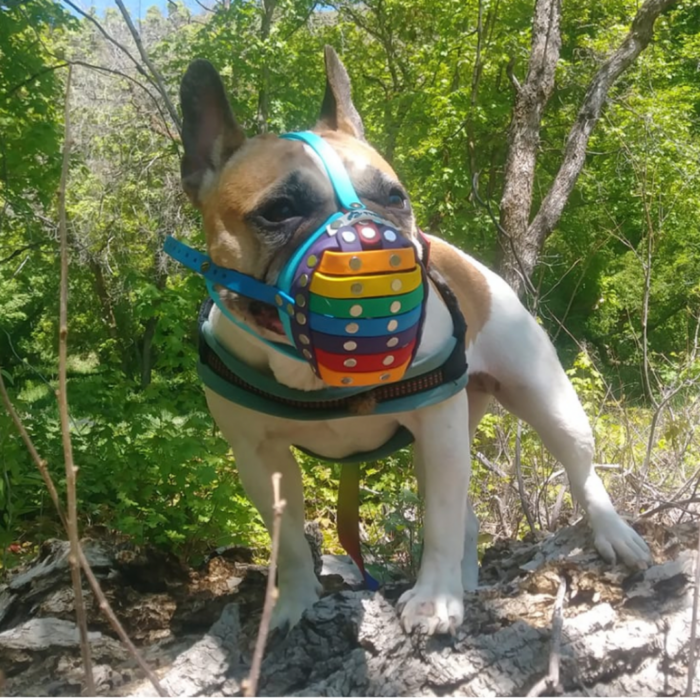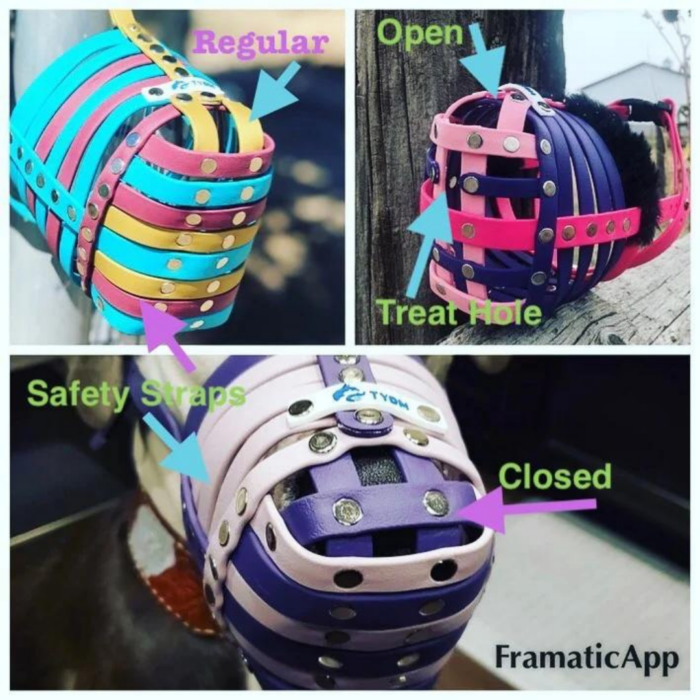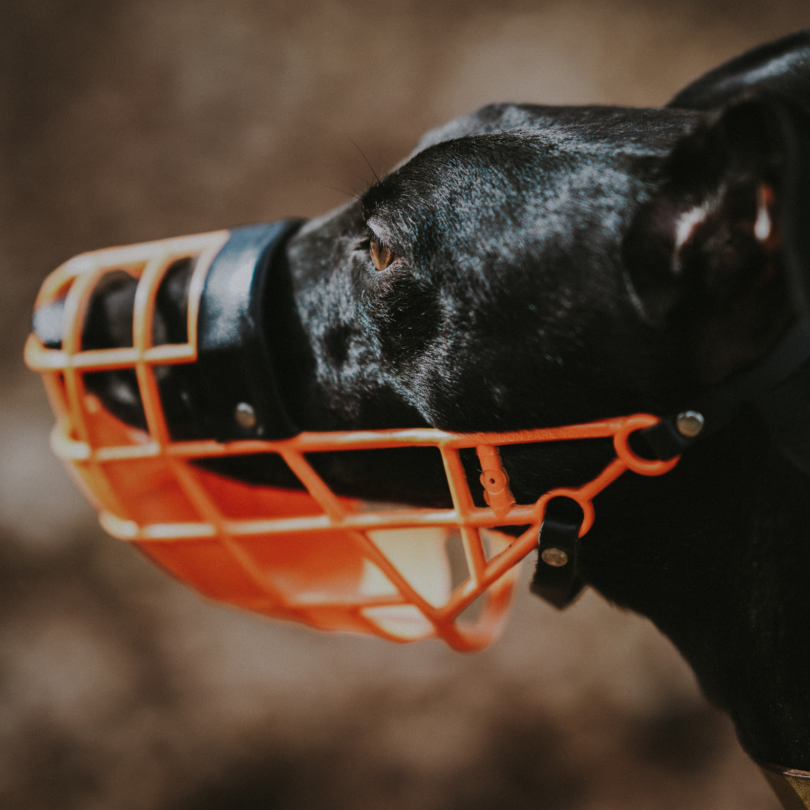In episode 42 of the Paws & Reward Podcast, I am joined by Amy Creaven to discuss the importance of muzzle training for your dog. Amy Creaven is a recovering ICU nurse and has been a Karen Pryor Academy Certified Training Partner since 2010. Prior to COVID-19, she worked with all types of canine behavioral cases privately. Currently, she is a work-from-home mother of two non-fur children and one amazing furry sidekick the Marvelous Ms. Moya as well as a multitude of chickens. Amy also teaches positive reinforcement rattlesnake avoidance workshops and a Fear Free Handling and Cooperative Care lab to the veterinary students at Colorado State University. Watch our conversation on my YouTube Channel.
When do you recommend muzzle training to clients?
There are many reasons muzzle training can be beneficial to you and your dog. The most common reason would be if the pet parent had a concern that their dog was at risk of biting other dogs and/or strangers out in public. Several other reasons you would muzzle train your dog include:
- Vet visits
- Post-Op recovery instead of a cone
- Inter-household aggression situations
- Pica (eating non-food items)
What are some considerations you take when fitting a dog for a muzzle?
First, determine, how long your dog needs to wear a muzzle. Is it for an hour-long walk or a 5-minute procedure at the vet’s office? We want to make sure the dog is comfortable in the muzzle.
When fitted correctly, basket muzzles should allow the dog to fully pant and should not rub on the eyes or nose. A trick to measuring the right size is to ask your dog to hold a toy or ball in their mouth. Then measure around their muzzle for the dimensions. This can closely mimic the room needed to allow for panting.
Otherwise, you can hold a measurement stick next to the dog while they are panting and take a photo. The muzzle should rest half an inch in front of their eyes, unless it’s a brachycephalic dog, then you need a specific muzzle for those breeds to accommodate their unique facial shape.

Can dogs still do damage while wearing a muzzle?
Yes. Management of your dog should still be implemented. “Bite proof” muzzles are still a tool, not a solution. Unpredictable events can still happen. There’s always some degree of failure for management/prevention tools.
What are some of your favorite techniques for muzzle training?
When muzzle training your dog, you want to associate the muzzle with lots of good things. If you have a severe resource guarder, please work with an experienced trainer.

Otherwise, you can start by cutting a piece of cardboard and placing it at the bottom of the muzzle. You can start feeding your dog his/her meal inside the muzzle as if it were a bowl. That way they can get used to the muzzle on their face, the sensory experience, and taking food from inside the muzzle.
Another technique for muzzle training includes teaching your dog to nose target different objects. For example, you can use a wide cup to start to mimic the shape of the muzzle. This is especially helpful if your dog already has a negative association with muzzle training and muzzle use. Once they are comfortable with targeting their nose into a variety of objects, you can introduce a new basket muzzle and practice the same muzzle training procedure.
After that step, add duration. Start by clicking and treating your dog for having their nose in the muzzle for a few seconds. Add to the duration over time and stagger it – long (5 seconds), short (2 seconds), long (5 seconds), short (1 second).
Lastly, work on movement. With the dog’s nose in the muzzle, take a step away and then reward. Gradually work on longer distances and more duration together.
It can be helpful to work with a professional if you have questions or a unique situation.
What are some of the challenges that take place during the muzzle training process?

Some dogs and people can become impatient with the process, but take your time and go slow. Making the muzzle a pleasant experience is vital. Go slow to go fast!
Learning the mechanics of giving and taking a treat through the muzzle is a learning experience for both you and the dog. If your dog is impatient for the treat, or you are frustrated getting it through the gate of the muzzle, take time to find the best way for both of you.
If your dog is still struggling or appears uncomfortable with the muzzle, take a step back and go slower. The whole point is for the dog to be neutral when wearing the muzzle, not bothered by it.
Thank you for being on the show!! Where can listeners find you online?
- Shop Muzzles!
- Website: www.trust-your-dog.com
- Instagram @trustyourdog you can follow Moya’s escapades @marvelousmsmoya
- Facebook @trustYDM

